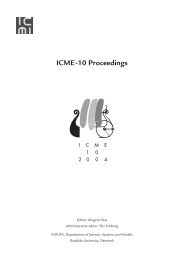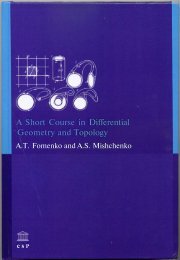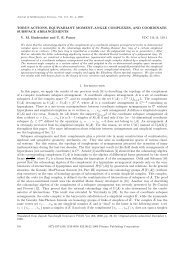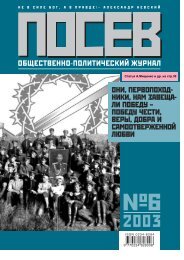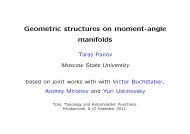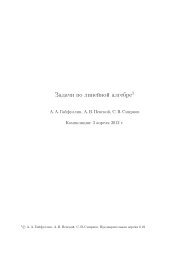pdf (English) - Geometry and Topology (Russian)
pdf (English) - Geometry and Topology (Russian)
pdf (English) - Geometry and Topology (Russian)
Create successful ePaper yourself
Turn your PDF publications into a flip-book with our unique Google optimized e-Paper software.
MOMENT-ANGLE COMPLEXES AND COMBINATORICS OF<br />
SIMPLICIAL MANIFOLDS<br />
VICTOR M. BUCHSTABER AND TARAS E. PANOV<br />
Let ρ : (D 2 ) m → I m be the orbit map for the diagonal action of torus T m on the unit<br />
poly-disk (D 2 ) m ⊂ C m . Each face of the cube I m = [0, 1] m (viewed as a cubical complex)<br />
has the form<br />
F I⊂J = {(y 1, . . . , y m) ∈ I m<br />
: y i = 0 if i ∈ I, y j = 1 if j /∈ J},<br />
where I ⊂ J are two subsets of the index set [m] = {1, . . . , m}. For each face F I⊂J put<br />
B I⊂J := ρ −1 (F I⊂J ). If #I = i, #J = j, then B I⊂J<br />
∼ = (D 2 ) j−i × T m−j .<br />
Definition 1. Let C be a cubical subcomplex of I m . The moment-angle complex ma(C)<br />
is the T m -invariant decomposition of the subset ρ −1 (|C|) ⊂ (D 2 ) m into blocks B I⊂J<br />
corresponding to the faces F I⊂J of complex C.<br />
Many combinatorial problems concerning cubical complexes may be treated by studying<br />
the equivariant topology of moment-angle complexes. In the present paper we realize this<br />
approach in the case of cubical complexes determined by simplicial complexes. Let K n−1<br />
be an (n − 1)-dimensional simplicial complex with m vertices, <strong>and</strong> |K| the corresponding<br />
polyhedron. If I = {i 1 , . . . , i k } ⊂ [m] is a simplex of K, then we would write I ∈ K.<br />
Define the following two cubical subcomplexes of I m :<br />
cub(K) = {F I⊂J : J ∈ K, I ≠ ∅}, cc(K) = {F I⊂J : J ∈ K}.<br />
Lemma 2. As a topological space, the complex cub(K) is homeomorphic to |K|, while<br />
cc(K) is homeomorphic to the cone | cone(K)|.<br />
The cubical complex cc(K) was introduced in [1] <strong>and</strong> then studied in [2]. The cubical<br />
complex cub(K) appeared in [3].<br />
✬ ✩ ✬ ✩<br />
a)<br />
D<br />
<br />
T 1<br />
b)<br />
D<br />
I <br />
T 0 1<br />
✫ ✪ ✫ ✪<br />
Denote the moment-angle complexes corresponding to cub(K) <strong>and</strong> cc(K) by W K <strong>and</strong><br />
Z K respectively. Consider the cellular decomposition of the poly-disk (D 2 ) m that is<br />
obtained by subdividing each factor D 2 into 0-dimensional cell 1, 1-dimensional cell T ,<br />
<strong>and</strong> 2-dimensional cell D, see Fig. a). Each cell of (D 2 ) m is a product of cells D i , T i , 1 i ,<br />
i = 1, . . . , m, i.e., can be written as D I T J 1 [m]\I∪J , where I, J are disjoint subsets of [m].<br />
Set D IT J := D IT J1 [m]\I∪J . Now it can be easily seen that Z K is cellular subcomplex of<br />
(D 2 ) m consisting of all cells D IT J such that I ∈ K.<br />
Lemma 3. The embedding T m = ρ −1 (1, . . . , 1) ↩→ Z K is a cellular map homotopic to the<br />
map to a point.<br />
As it was shown in [2], for any field k there is the following isomorphism of algebras:<br />
(1) H ∗ (Z K ) ∼ = Tor k[v1 ,...,v m ] k(K), k = H ∗ k(K) ⊗ Λ[u 1 , . . . , u m ], d ,<br />
Partially supported by the <strong>Russian</strong> Foundation for Fundamental Research grant no. 99-01-00090.<br />
1
2 VICTOR M. BUCHSTABER AND TARAS E. PANOV<br />
where k(K) is the Stanley–Raisner ring of complex K, <strong>and</strong> the differential d is defined<br />
by d(v i ) = 0, d(u i ) = v i , i = 1, . . . , m. The Tor-algebra from (1) is naturally a bigraded<br />
algebra with bideg(v i ) = (0, 2), bideg(u i ) = (−1, 2). The calculation of the ring H ∗ (Z K )<br />
allowed to describe the multiplicative structure in the cohomology of the complement of<br />
a coordinate subspace arrangement in C m [2].<br />
In [1] there was introduced the subcomplex C ∗ (K) ⊂ k(K) ⊗ Λ[u 1, . . . , u m] spanned by<br />
monomials u J <strong>and</strong> v I u J such that I ∩ J = ∅, I ∈ K. It was also shown there that the<br />
cohomology of C ∗ (K) is also isomorphic to that of Z K. Denote by C ∗(Z K) <strong>and</strong> C ∗ (Z K)<br />
the chain <strong>and</strong> the cochain complex for type a) cellular decomposition of Z K respectively.<br />
Theorem 4. Let (D I T J ) ∗ ∈ C ∗ (Z K ) denote the cellular cochain dual to the cell D I T J ∈<br />
Z K . The correspondence v I u J ↦→ (D I T J ) ∗ defines a canonical isomorphism of complexes<br />
C ∗ (K) <strong>and</strong> C ∗ (Z K), each of which calculates H ∗ (Z K).<br />
The pair (Z K , T m ) acquires a bigraded cellular structure by setting bideg(D i ) = (0, 2),<br />
bideg(T i ) = (−1, 2), bideg(1 i ) = (0, 0). Put b −q,2p (Z K , T m ) = dim H −q,2p [C ∗ (Z K , T m )].<br />
Consider the new cellular decomposition of the poly-disc (D 2 ) m that is obtained by subdividing<br />
each factor D 2 into 5 cells D, T , I, 1, 0, see Fig. b). This allows to introduce a bigraded<br />
cellular structure on W K <strong>and</strong> define the numbers b q,2p(W K) = dim H q,2p[C ∗(W K)].<br />
Put<br />
χ(Z K , T m ; t) = ∑ p,q<br />
(−1) q b −q,2p (Z K , T m )t 2p ,<br />
χ(W K ; t) = ∑ p,q<br />
(−1) q b q,2p (W K )t 2p .<br />
Let f i be the number of i-simplices of K, <strong>and</strong> (h 0, . . . , h n) the h-vector of K determined<br />
from the equation h 0 t n + . . . + h n−1 t + h n = (t − 1) n + f 0 (t − 1) n−1 + . . . + f n−1 .<br />
Theorem 5. Put h(t) = h 0 + h 1 t + · · · + h n t n . Then<br />
χ(Z K , T m ; t) = (1 − t 2 ) m−n h(t 2 ) − (1 − t 2 ) m ,<br />
χ(W K ; t) = (1 − t 2 ) m−n h(t 2 ) + (−1) n−1 h n (1 − t 2 ) m .<br />
Lemma 6. If |K| ∼ = S n−1 (i.e., K is a simplicial sphere), then Z K is a closed manifold.<br />
Suppose now that K n−1 is a simplicial manifold. Then the complex Z K generally<br />
fails to be a manifold. However, removing from Z K a small neighbourhood U ε(T m ) of<br />
the orbit ρ −1 (1, . . . , 1) ∼ = T m we obtain manifold W K = Z K \ U ε (T m ) with boundary<br />
∂W K = |K| × T m .<br />
Theorem 7. The manifold (with boundary) W K is equivariantly homotopy equivalent to<br />
the complex W K. There is a canonical homeomorphism of pairs (W K, ∂W K) → (Z K, T m ).<br />
The relative Poincaré duality isomorphisms for W K imply<br />
Taking into account Theorem 5 we obtain<br />
χ(W K; t) = (−1) m−n t 2m χ(Z K, T m ; 1 t ).<br />
Corollary 8. Let K n−1 be a simplicial manifold. Then<br />
h n−i − h i = (−1) i (h n − 1) n i<br />
= (−1) i χ(K n−1 ) − χ(S n−1 )<br />
where χ(·) denotes the Euler number.<br />
n<br />
i<br />
, i = 0, 1, . . . , n,<br />
Rewriting the equation (8) in terms of the f-vector we come to more complicated<br />
equations, which were deduced in [4], [5]. For |K| = S n−1 Corollary 8 gives the classical<br />
Dehn–Sommerville equations. In the particular case of PL-manifolds the topological invariance<br />
of numbers h n−i −h i (which follows directly from Corollary 8) was firstly observed<br />
by Pachner in [6, (7.11)].<br />
The extended version of this article is http://xxx.lanl.gov/abs/math.AT/0005199.<br />
The authors wish to express special thanks to Oleg Musin for stimulating discussions <strong>and</strong><br />
helpful comments, in particular, for drawing our attention to the results of [4] <strong>and</strong> [6].
MOMENT-ANGLE COMPLEXES AND SIMPLICIAL MANIFOLDS 3<br />
References<br />
[1] V. M. Buchstaber <strong>and</strong> T. E. Panov. Proceedings of the Steklov Institute of Mathematics 225<br />
(1999), 87–120.<br />
[2] V. M. Buchstaber <strong>and</strong> T. E. Panov. (<strong>Russian</strong>), Zap. Nauchn. Semin. POMI 266 (2000), 29–50.<br />
[3] M. A. Shtan’ko <strong>and</strong> M. I. Shtogrin. <strong>Russian</strong> Math. Surveys 47 (1992), no. 1, 267–268.<br />
[4] B. Chen, M. Yan. Proceedings of the Steklov Institute of Mathematics 221 (1998), 305–319.<br />
[5] V. Klee. Canadian J. Math. 16 (1964), 517–531.<br />
[6] U. Pachner. European J. Combinatorics 12 (1991), 129–145.<br />
Department of Mathematics <strong>and</strong> Mechanics, Moscow State University, 119899 Moscow, RUSSIA<br />
E-mail address: buchstab@mech.math.msu.su tpanov@mech.math.msu.su



